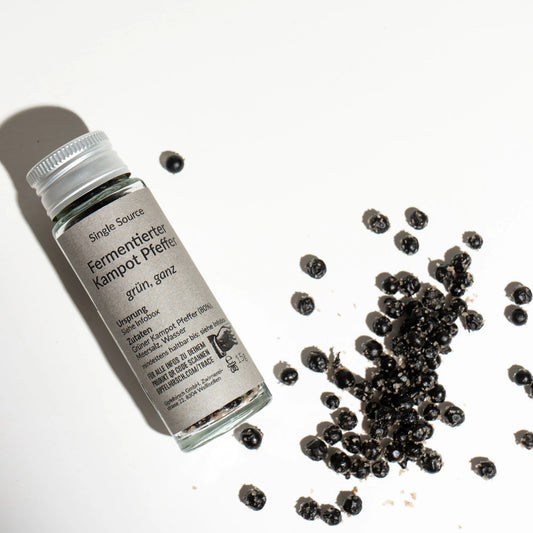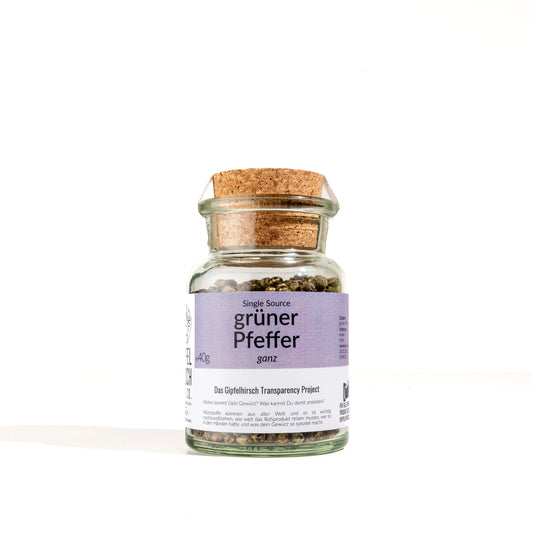Kategorie: Pfeffer
Entdecke die spannende Welt der feinen Pfeffer! In unserer exklusiven Pfefferkollektion findest du die besten Pfeffersorten aus aller Welt, die deine kulinarischen Kreationen aufpeppen. Von den edlen Kampot-Pfeffern in rot, weiss und schwarz bis hin zu den exotischen Langpfeffern und dem prickelnden Sichuanpfeffer – wir bieten dir ein breites und aufregendes Spektrum an Geschmäckern und Aromen, natürlich mit dem gewissen Kick.
Jeder Pfeffer in unserer Auswahl wurde wegen seines einzigartigen Geschmacksprofils und seiner Vielseitigkeit in der Küche ausgewählt. Wir achten darauf, nur die beste Qualität und aussergewöhnlichen Geschmack zu wählen, ohne Zusätze. So kannst du dich voll und ganz auf die komplexen Aromen konzentrieren, die diese Pfeffersorten deinen Gerichten verleihen. Viel Spass beim Genießen!
-
roter Kampot Pfeffer
Normaler Preis CHF 15.00Normaler PreisGrundpreis entspricht CHF 21.43 / pro 100g -
Kampot Pfeffer, schwarz
Normaler Preis CHF 15.00Normaler PreisGrundpreis entspricht CHF 18.75 / pro 100g -
Schwarzer Pfeffer
Normaler Preis CHF 8.00Normaler PreisGrundpreis entspricht CHF 10.00 / pro 100g -
Fermentierter Kampot Pfeffer
Normaler Preis CHF 10.00Normaler PreisGrundpreis entspricht CHF 66.67 / pro 100g -
Szechuanpfeffer, ganz
Normaler Preis CHF 8.50Normaler PreisGrundpreis entspricht CHF 18.89 / pro 100g -
 Ausverkauft
AusverkauftKampot Pfeffer, weiss
Normaler Preis CHF 15.00Normaler PreisGrundpreis entspricht CHF 16.67 / pro 100g -
Pinker Pfeffer (Schinusbeeren), ganz
Normaler Preis CHF 14.00Normaler PreisGrundpreis entspricht CHF 28.00 / pro 100g -
Banasura Hochland Pfeffer, schwarz, ganz
Normaler Preis CHF 14.00Normaler PreisGrundpreis entspricht CHF 17.50 / pro 100g -
Grüner Pfeffer, ganz
Normaler Preis CHF 10.00Normaler PreisGrundpreis entspricht CHF 25.00 / pro 100g -
Langer Pfeffer, ganz
Normaler Preis CHF 17.00Normaler PreisGrundpreis entspricht CHF 28.33 / pro 100g -
 Ausverkauft
AusverkauftKampot Pfeffer Geschenkset
Normaler Preis CHF 50.00Normaler PreisGrundpreis entspricht CHF 20.83 / pro 100g
Erfahre mehr über deine würzigen Begleiter
Pfefferwissen
Die vier Gesichter des Pfeffers: Eine geschmackvolle Reise
Pfeffer, bekannt als der „König der Gewürze“, begeistert seit über 2.000 Jahren Gaumen weltweit. Ursprünglich aus den üppigen Landschaften Südindiens stammend, ist schwarzer Pfeffer (Piper nigrum) eines der ältesten und am weitesten verbreiteten Gewürze. Sein Weg von grünen Beeren zu den aromatischen schwarzen Pfefferkörnern, die wir heute verwenden, ist ein Beweis für seine anhaltende Beliebtheit. Doch Pfefferkörner gibt es in verschiedenen Formen, die jeweils ein einzigartiges Geschmackserlebnis bieten und verschiedene kulinarische Kreationen bereichern.
Schwarzer Pfeffer wird geerntet, während die Beeren noch grün und unreif sind. Der Trocknungsprozess verwandelt diese Beeren in die kräftigen, aromatischen schwarzen Pfefferkörner, die in Küchen weltweit bekannt sind. Sein Geschmack ist scharf und würzig mit erdigen Untertönen, was ihn zu einer vielseitigen Zutat macht. Ob zum Würzen von Fleisch, Gemüse, Suppen oder Saucen, das kräftige Profil von schwarzem Pfeffer ist in unzähligen Gerichten unverzichtbar. Seine Vielseitigkeit macht ihn auch zu einem Grundpfeiler in Gewürzmischungen und Rubs, die einer Vielzahl von Rezepten Tiefe und Wärme verleihen. Der Geschmack verändert sich zusätzlich leicht, je nach Anbaugebiet. Für mehr Infos zu den Anbaugebieten haben wir einen Blogeintrag vorbereitet: Warum Pfeffer nicht gleich Pfeffer ist: Anbaugebiete
Grüner Pfeffer bietet eine frischere, mildere Alternative. Diese Pfefferkörner werden ebenfalls vor der Reifung geerntet und durch Einlegen oder Gefriertrocknung konserviert, wodurch ihr lebhafter Geschmack erhalten bleibt. Weniger scharf als schwarzer Pfeffer, sind grüne Pfefferkörner ideal, um eine helle, lebhafte Note zu Salaten, Meeresfrüchten und cremigen Saucen hinzuzufügen. Ihr milderer Geschmack eignet sich für Gerichte, die von einem subtilen Pfefferakzent profitieren.
Obwohl Weisser Pfeffer von der gleichen Pflanze kommt wie schwarzer Pfeffer, wird er anders verarbeitet. Durch das Entfernen des Fruchtfleisches der reifen, roten Pfefferkörner entsteht ein milderes, raffinierteres Gewürz. Dieser Prozess verleiht dem weissen Pfeffer einen subtilen erdigen oder fermentierten Geschmack, der ihn ideal für Gerichte macht, bei denen ein leichterer Touch gewünscht ist. Er wird häufig in Rahmsaucen, Kartoffelbrei und weissen Suppen verwendet sowie in der asiatischen Küche, um eine nuancierte Schärfe zu bieten, ohne das Aussehen des Gerichts zu verändern. Weisser Pfeffer ist aufgrund der zusätzlichen Verarbeitungsschritte tendenziell teurer.
Rote Pfefferkörner sind vollständig reife Beeren, die getrocknet werden, um ihre charakteristische rote Farbe zu erreichen. Ihr Geschmack ist eine reiche Mischung aus Süsse und Wärme, mit einer sanften Schärfe, die nur leicht weniger intensiv ist als schwarzer Pfeffer. Dies macht sie zu einer fantastischen Wahl für Gewürzmischungen, Einlegen und Rezepte, bei denen ein süsseres, komplexeres Gewürz bevorzugt wird. Roter Pfeffer verbessert nicht nur den Geschmack, sondern fügt den Gerichten auch visuelle Attraktivität hinzu, was sie zu einer tollen Ergänzung für Fleisch, Saucen und Marinaden macht.
Einzigartige Pfeffersorten entdecken
Pfeffer gibt es in verschiedenen Formen, und jede bringt ihren eigenen Twist in die Welt der Gewürze. Während schwarzer Pfeffer und seine Verwandten allgemein bekannt sind, bieten andere Pfeffersorten wie Langer Pfeffer, Szechuan-Pfeffer und Pink Pepper einzigartige Geschmacksnuancen und Verwendungsmöglichkeiten. Diese weniger bekannten Sorten bereichern kulinarische Erlebnisse, indem sie Tiefe und Vielfalt in die Gerichte bringen. Zwar heissen sie Pfeffer, haben aber botanisch nichts mit dem echten Pfeffer zu tun. Trotzdem sind sie allesamt richtig lecker und fügen eine komplexe und auch scharfe Noten deinen Speisen hinzu.
Langer Pfeffer (Piper longum) ist ein historisches Gewürz, das seinen Ursprung in Indien und Indonesien hat und seit alten Zeiten verwendet wird. Im Gegensatz zum schwarzen Pfeffer zeichnet sich Langer Pfeffer durch sein komplexes Geschmacksprofil aus, das intensive Schärfe mit süssen, leicht schokoladigen Untertönen kombiniert. Er ist wärmer und reichhaltiger als sein bekannterer Verwandter. Seine Vielseitigkeit zeigt sich in scharfen Fleischmarinaden, herzhaften Eintöpfen und aromatischen Gewürzmischungen. Ausserdem verleiht der exotische Geschmack von Langer Pfeffer Desserts eine interessante Tiefe und verwandelt traditionelle Süssspeisen in etwas Aussergewöhnliches.
Weiter nach Osten, Szechuan-Pfeffer (Zanthoxylum spp.) ist ein wesentlicher Bestandteil der Sichuan-Küche und stammt aus der Sichuan-Region in China. Anders als echter Pfeffer zeichnet sich Szechuan-Pfeffer durch seine betäubende Wirkung in Kombination mit einem würzigen, zitronigen Geschmack aus. Die Schärfe des Szechuan-Pfeffers liegt nicht in der Hitze, sondern in der einzigartigen Sensation, die er Gerichten eine besondere Note verleiht. Er ist eine grundlegende Zutat in Gerichten wie Mapo Tofu und Kung Pao Chicken und bringt den charakteristischen Geschmack, der die Sichuan-Küche definiert. Neben herzhaften Gerichten kann Szechuan-Pfeffer auch in Gewürzmischungen und sogar Desserts verwendet werden und sorgt für einen unerwarteten und erfreulichen Kick. Auch hier gibt es wieder Unterschiede und nicht jeder Szechuanpfeffer ist gleich. Kommerziell gibt es 4 Sorten, die angebaut werden, wobei der klassische Szechuanpfeffer aus der Szechuan Region in China am verbreitesten ist. Dann gibt es zum Beispiel noch den Sansho Pfeffer, eine japanische Sorte, die mehr Zitrustöne hat oder den Timut Pfeffer aus Nepal, der eher Grapefruit Aromen mit sich bringt.
Zuletzt kommt der pinke Pfeffer (Schinus terebinthifolius) aus Brasilien und anderen Teilen Südamerikas. Trotz seines Namens ist Pink Pepper kein echter Pfeffer, sondern die getrockneten Beeren des Brasilianischen Pfefferbaums. Er bietet einen milden, süssen und blumigen Geschmack mit nur einem Hauch von Pfefferschärfe. Weniger intensiv als traditionelle Pfefferkörner, wird Pink Pepper für sein zartes fruchtiges Aroma geschätzt. Er eignet sich hervorragend zum Garnieren von Salaten, Meeresfrüchten und Desserts, wo er sowohl einen Farbtupfer als auch einen sanften Geschmackskick hinzufügt. Seine Vielseitigkeit macht ihn zu einer tollen Ergänzung für Käse und verschiedene Gerichte.
Unterschiede zwischen echtem und unechtem Pfeffer
Pfeffer ist ein Grundpfeiler der globalen Küche, aber nicht alle Pfefferarten sind gleich. Die Unterschiede zwischen echtem Pfeffer und unechtem Pfeffer zu verstehen, kann dein Gewürzrepertoire erweitern und dein Kochen auf ein neues Level heben. Jede Kategorie hat ihre eigenen einzigartigen Eigenschaften, die Geschmack, Schärfe und kulinarische Anwendung beeinflussen.
Der erste grosse Unterschied liegt in der botanischen Klassifikation. Echter Pfeffer, wie schwarzer, weisser, grüner und roter Pfeffer, stammt aus der Familie der Piperaceae und wird alle von der Pflanze Piper nigrum oder ihren Variationen gewonnen. Diese Pfefferarten haben einen gemeinsamen Ursprung und botanische Merkmale, die zu ihren ähnlichen, aber doch unterschiedlichen Geschmacksprofilen beitragen. Im Gegensatz dazu gehören unechte Pfefferarten zu ganz anderen Pflanzenfamilien. Zum Beispiel stammt Szechuanpfeffer aus der Familie der Rutaceae, während rosa Pfeffer aus der Familie der Anacardiaceae kommt. Diese botanische Vielfalt ist ein grundlegender Grund für ihre einzigartigen Geschmäcker und Verwendungen.
Geschmack und Schärfe verdeutlichen den Unterschied zwischen diesen beiden Kategorien. Echter Pfeffer ist bekannt für seine gleichmässige Schärfe und Pungency. Ihre Geschmäcker können von erdig und kräftig, wie bei schwarzem Pfeffer, bis hin zu hell und zitrusartig, wie bei weissem Pfeffer, reichen. Unechter Pfeffer hingegen bietet vielfältigere und manchmal subtilere Geschmacksprofile. Szechuanpfeffer beispielsweise hat eine würzige, zitrusartige Note mit einer betäubenden Wirkung, während rosa Pfefferkörner eine milde, süsse und blumige Note hinzufügen. Die Schärfegrade und Geschmackskomplexität von unechtem Pfeffer können erheblich variieren und bieten einzigartige kulinarische Erlebnisse.
Die kulinarischen Anwendungen zeigen ihre praktischen Einsatzmöglichkeiten beim Kochen. Echter Pfeffer ist vielseitig und wird in vielen Küchen zur Würzung und für Gewürzmischungen verwendet. Seine gleichmässige Schärfe und der Geschmack machen ihn für fast jedes Gericht geeignet, von alltäglichen Mahlzeiten bis zu Gourmetkreationen. Unechter Pfeffer hingegen wird oft wegen seiner einzigartigen Geschmäcker geschätzt und wird typischerweise in spezifischen regionalen oder Gourmetrezepten verwendet. Er verleiht Gerichten, die mehr als nur Schärfe benötigen, eine besondere Note und erweitert die Komplexität und Charakteristik des Essens.
Die historische und kulturelle Bedeutung unterstreicht ihre Rolle in der globalen Küche. Echter Pfeffer war über Jahrhunderte ein zentraler Bestandteil des Gewürzhandels und hat globale kulinarische Praktiken und Wirtschaften geprägt. Seine reiche Geschichte spiegelt seine weitreichende Nutzung und seinen Einfluss wider. Unechter Pfeffer, obwohl oft spezifisch für bestimmte Kulturen, trägt zur regionalen Charakteristik und Tiefe der Gerichte bei. Er spielt eine wichtige Rolle in traditionellen Rezepten und regionalen Spezialitäten und bereichert das kulinarische Gefüge seiner jeweiligen Küchen.
Für noch mehr Infos zu den verschiedenen Pfeffersorten (und Pfeffer, die kein Pfeffer sind) gibts einen Blogpost dazu: Warum Pfeffer nicht gleich Pfeffer ist: die Sorten
Kulinarische Verwendung von Pfeffer
Pfeffer bringt eine ganze Palette an Geschmäckern und Aromen in verschiedene Gerichte, und jede Sorte hat ihren eigenen Charakter. Ob für Fleischgerichte, Meeresfrüchte oder Desserts – Pfeffer ist ein vielseitiges Gewürz, das deine Küche aufpeppen kann. Hier schauen wir uns an, wie verschiedene Pfeffersorten in unterschiedlichen Gerichten eingesetzt werden können.
Fleischgerichte profitieren enorm von den kräftigen Geschmäckern des Pfeffers. Schwarzer Pfeffer, der in vielen Küchen ein Dauerbrenner ist, wird oft für Marinaden, Rubs und als Würze für Rind, Hähnchen und Schwein verwendet. Sein scharfer, würziger Geschmack hebt die natürlichen Aromen des Fleisches hervor. Langer Pfeffer, mit seinem reichen und warmen Aroma, ist ideal für Currys und Eintöpfe, da er eine komplexe Geschmackstiefe verleiht. Wenn du deinen Gerichten eine extra Portion Spannung verleihen möchtest, bringt Szechuan-Pfeffer eine einzigartige betäubende Schärfe, die perfekt für Sichuan-Gerichte und Wok-Rezepte ist.
Auch Meeresfrüchte werden durch verschiedene Pfeffersorten wunderbar ergänzt. Grüne Pfefferkörner sind perfekt für Fisch und Meeresfrüchte, da sie einen frischen, milden Pfeffergeschmack bieten, der die zarten Aromen von Fisch und Schalentieren hervorhebt. Rosa Pfefferkörner, mit ihrem zarten, süßen Aroma, bringen Farbe und Geschmack in Meeresfrüchte-Gerichte und verbessern den Geschmack von verschiedenen Meeresgerichten.
Bei Saucen und Suppen können Pfeffer subtil den Gesamtgeschmack beeinflussen. Weisser Pfeffer wird oft in cremigen Saucen und Suppen verwendet, um eine milde Schärfe hinzuzufügen, ohne die Farbe des Gerichts zu verändern. Seine milde Würze passt perfekt in leichtere Gerichte. Rote Pfefferkörner sind hingegen super, um Saucen eine süße und wärmende Note zu verleihen, besonders in Mischungen und beim Einlegen, wo ihr lebhafter Geschmack besonders zur Geltung kommt.
Salate und Gemüse profitieren von den einzigartigen Eigenschaften des Pfeffers. Rosa Pfefferkörner setzen farbliche Akzente und sorgen für einen aromatischen Touch in Salaten und Gemüserezepten, wodurch sowohl das Aussehen als auch der Geschmack verbessert werden. Grüne Pfefferkörner bringen einen frischen, würzigen Geschmack, der perfekt für Gemüsesalate und leichte Saucen ist und den Gerichten eine helle, pfeffrige Note verleiht.
Zu guter Letzt können auch Desserts und besondere Rezepte mit dem richtigen Pfeffer veredelt werden. Szechuan-Pfeffer bringt eine überraschende und faszinierende Schärfe in Schokoladendesserts und fruchtbasierte Gerichte, was zu einem unerwartet aber köstlichen Geschmackserlebnis führt. Langer Pfeffer fügt eine exotische, süss-würzige Note hinzu, die kreative Desserts und Gourmet-Rezepte aufwertet und traditionellen Süßspeisen eine neue Wendung gibt.











